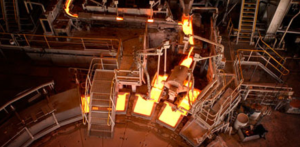Australia’s copper sector is on the rise as global issues of energy, climate change and transportation become more urgent.
As the looming 2019 worldwide copper deficit steps closer to reality, high-calibre international copper experts from Chile, the United Kingdom and Australia will join leading copper miners and innovators in Adelaide next month for the Copper to the World conference (details here).
A sign of the times is that ongoing demand for the red metal means miners will need to produce as much copper in the next 25 years as has been mined in humankind’s history to meet growth in global industrial production and higher investment in energy infrastructure with emerging economies driving much of the growth.
As it stands, Australia is a major contributor to world copper stocks as the world’s 3rd largest exporter of copper ores and concentrates and the 7th largest producer of copper.
The South Australian Government has developed the Copper to the World program with a national and global copper audience in mind to deliver a global perspective on the future of copper, delving into trends, opportunities and developments across the copper value chain to address rising demand.
New sources of demand are moving at rapid pace. Take the increased global production of electric vehicles – containing more than three times the weight of copper compared to regular vehicles – that is expected to raise copper consumption by 300,000t alone in 2018 and 2019.
Filling the copper shortfall
Australian producers are working to supply a great big chunk of the emerging copper inventory gap, as they incorporate the latest technologies to drive success and productivity.
BHP is forging ahead with its investment plans to expand the worlds’ third largest copper deposit at Olympic Dam in the north of South Australia. This year the mine celebrated the completion of a $350 million smelter upgrade and upgraded works on the refinery, concentrator and other key infrastructure and site technology to further drive processing productivity. This follows the production of new ore from its Southern Mine Area – the expansion involving a quarter of a billion dollar investment and the scale of development and associated infrastructure work on par with five new standalone mines.
OZ Minerals has extended the life of its Prominent Hill copper mine. In April, primary approvals for its almost $1 billion Carrapateena copper gold project have been secured from the South Australian and Commonwealth Governments, clearing the way for Phase 2 of construction to commence for processing and above ground infrastructure. OZ is innovating across the board from analytics to aid decision-making in its field exploration programs to drive mining efficiencies by tapping into the latest communication and digital platforms.
Newcrest Mining, with Australian copper operations at Cadia Valley, NSW and Telfer, WA has also joined the program to share its insights into incorporating technological approaches to its operations.
More broadly Australia’s copper exploration sector is upbeat. Argonaut’s Torrens Exploration project holds promise as filling in South Australia’s copper inventory, with the company identifying 10 exploration targets, each with the potential to host an Olympic Dam-sized deposit.
Copper miners Havilah and Hillgrove will share presentations on copper mineralistion styles in a company segment at the conference.
Stretching thinking
Decision makers and thought leaders will stretch thinking across the value chain on ways to meet the growth trajectory with up-to-date analysis, case studies and technical know-how on big opportunities facing the industry.
Disruptive technologies are also bringing new opportunities for productivity and the conference will drive in-depth discussion. Speakers from CSIRO Manufacturing and the International Copper Association will discuss new technologies along the copper mining value-chain along with Hatch on advances in the smelting space.
Working towards strengthening environmental and social performance and community acceptance is an ongoing goal for the sector, to be covered by Kim Ferguson, chair of the International Council of Mining and Metals Closure Working Group.
The Discovery segment of the program will reinforce why Australia is the place to come for copper exploration – with the success rate for finding copper deposits over the past decades double the world average. The past year has seen companies bring forward a tranche of excellent drill intersections, resource upgrades, feasibility studies and advanced projects.
With slim pickings for outcropping ore bodies a challenge worldwide, improving exploration undercover remains a challenge. Answering the call to improve exploration performance will be speakers from the UNCOVER initiative and AMIRA. The UNCOVER initiative is pooling specialist expertise across the nation in a well-coordinated national effort in the ongoing effort to unearth economic mineral deposits.
View the full Copper to the World program and register here.
For further information: Charles Moore (charles.moore@sa.gov.au)



